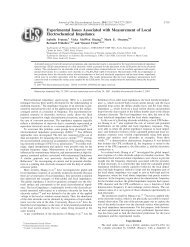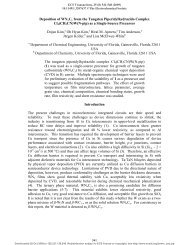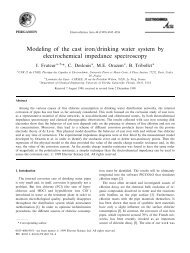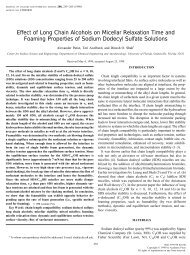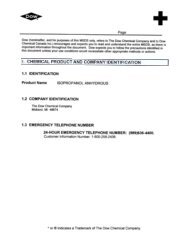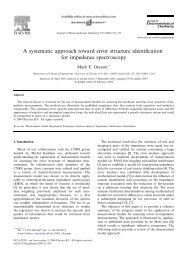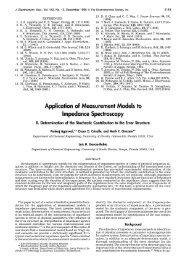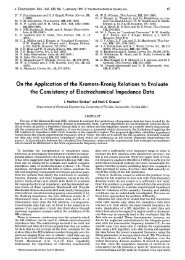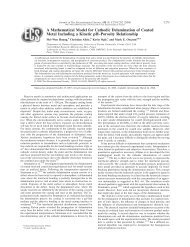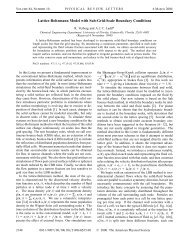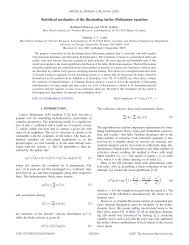Batch Distillation Theory - Chemical Engineering
Batch Distillation Theory - Chemical Engineering
Batch Distillation Theory - Chemical Engineering
You also want an ePaper? Increase the reach of your titles
YUMPU automatically turns print PDFs into web optimized ePapers that Google loves.
<strong>Batch</strong> <strong>Distillation</strong> <strong>Theory</strong>Department of <strong>Chemical</strong> <strong>Engineering</strong>Unit Operations LaboratoryThis handout provides important information on filtration theory and related issues:o <strong>Batch</strong> <strong>Distillation</strong> <strong>Theory</strong>o Determination of Composition by Gas Chromatographyo Computer Simulationo Degrees of Freedom/Sensitivityo Material and Energy Balanceso Propertieso Statistical Analysiso Important Remarks<strong>Batch</strong> <strong>Distillation</strong> <strong>Theory</strong>The theory is well developed for the prediction of distillation column operations. This sectionprovides an overview of some of the equations and theory associated with batch distillation. Foradditional theory development, see Resources.In batch mode, with no feed, vapor from the reboiler rises up the trays in the column and isfinally liquefied in the condenser. This condensed liquid is either drawn off or reintroduced intothe top of the column. Each tray of the column is assumed to be in vapor-liquid equilibrium.Geankoplis (1993) (see Resources) provides excellent diagrams illustrating the flows within adistillation column and the equilibrium on each tray.Several approaches can be taken:• Graphical Methods (McCabe-Thiele method and Ponchon-Savart method)• Shortcut Methods (e.g. Fenske-Underwood-Gilliland method)• Rigorous plate-to-plate calculations (using computer software)The graphical and shortcut methods are specifically for steady state operations. While they donot apply directly to the unsteady operation of batch distillation (except for the special case oftotal reflux), they can be useful in initially characterizing a column. For total reflux calculations,the Fenske equation (part of the FUG Shortcut Method) can be used to determine the number ofplates required for a given separation. The rigorous plate-to-plate calculations can easily beperformed with available computer aided engineering flowsheet simulation programs or specialpurpose distillation programs.Modified: 4/19/2007 Kevin M. Sapp page 1/4Original Document: Jullie Lawson © 2007
Determination of Composition by Gas ChromatographyDepartment of <strong>Chemical</strong> <strong>Engineering</strong>Unit Operations Laboratoryo You will be injecting 0.1 micro-liter sampleso At the beginning of each lab period, inject ethanol, isopropanol, and methanol standards.Note the retention time for each of these peaks.o Use the retention time for the standard peaks to identify peaks from your samples.o Use the relative peak areas of the components in your sample to determine the molefractions of components in the sample.Computer SimulationUsing your knowledge and resources on <strong>Batch</strong> <strong>Distillation</strong> <strong>Theory</strong>, develop a theoretical basisfor predicting dynamic behavior of the distillation column for your experimental conditions andsteady-state temperatures, pressures, flows, compositions, etc. for operation under total refluxconditions. Use these results to plan your experimental runs then compare your actual resultswith those predicted.HYSYS is an excellent programming resource for computer simulation of distillation columns. Atutorial is available online at http://hysys.che.ufl.edu/unit_op_lab_examples/index.html.Dynamic Simulationo Several computer programs are available to perform the dynamic calculations,and return the tray-by-tray characteristics as a function of time.o The HYSYS Plant flowsheet simulation package can be run in dynamic mode forthis purpose.o Ideally, you would like to determine the following as a function of time:• distillate product composition• bottoms product composition• stage by stage composition profile• stage by stage flow profile• heat transfer rate to the condenser• heat transfer rate to the reboilero And determine the• effect of Murphree efficiency on the above• time to reach a specific distillate concentrationModified: 4/19/2007 Kevin M. Sapp page 2/4Original Document: Jullie Lawson © 2007
Department of <strong>Chemical</strong> <strong>Engineering</strong>Unit Operations LaboratorySteady State Simulation (Total Reflux Only)o Several computer programs are available to perform the dynamic calculations,and return the tray-by-tray characteristics as a function of time.o The HYSYS Plant flowsheet simulation package run in steady-state mode isrecommended for this.o Ideally, you would like to determine steady-state values for:• distillate product composition• bottoms product composition• stage by stage composition profile• stage by stage flow profile• heat transfer rate to the condenser• heat transfer rate to the reboilero And determine the:• effect of Murphree efficiency on the aboveTray Efficiency EvaluationDetermining the efficiency of the trays in the column is an iterative trial and errorprocedure. First the programs or simulation packages (e.g. in HYSYS Plant simulation)must be setup to simulate the operation of the column. Next, the user guesses the trayefficiencies and the computer performs a tray-by-tray calculation to determine theconcentration of the distillate and bottoms products. If the values of the calculateddistillate and bottoms concentrations equal to the values found experimentally, then theguessed efficiencies are assumed to be correct. Otherwise, another estimate of theefficiencies is made and the program should be executed again. This is repeated until thepredicted product compositions are the same as those determined experimentally.Degrees of Freedom/SensitivityThe main independent variables available for study in the experiments include:• Flow rates (feed, distillate, bottoms)• Reflux ratio• Steam flow rate• Condenser water flow rateConsider effects of changes of these variables on key distillation performance indicators. Notethat there are limits to the control of these variables with the equipment available, and not all ofthese variables will affect performance in a measurable way.Modified: 4/19/2007 Kevin M. Sapp page 3/4Original Document: Jullie Lawson © 2007
Department of <strong>Chemical</strong> <strong>Engineering</strong>Unit Operations LaboratoryMaterial and Energy BalancesUse the experimentally determined compositions and flow rates to determine material balances.Also perform energy balances over the column, around the reboiler, and around the condenser,determining duties and heat transfer coefficients as needed. Resolve any data discrepancies andobtain closure on the material and energy balances.PropertiesProperties for ethanol and isopropanol are well known. Material and Safety Data Sheets for thesemajor components, as well as methanol, methyl isobutyl ketone, and ethyl acetate, which arepresent in small amounts, are available for download on the <strong>Batch</strong> <strong>Distillation</strong> Safety webpage.HYSYS DISTIL can be used to create vapor-liquid equilibrium curves for the binary system ofethanol and isopropanol, as well as the ternary system of methanol, ethanol, and isopropanol.Preparation of XY phase diagrams and HXY diagrams for the experimental conditions isstrongly recommended. Note the importance of selecting an appropriate property estimationmodel.Statistical AnalysisApply appropriate statistical procedures to determine the apparent error in results.Important RemarksWhenever possible, measure variables several times and different ways to verify values.Modified: 4/19/2007 Kevin M. Sapp page 4/4Original Document: Jullie Lawson © 2007



